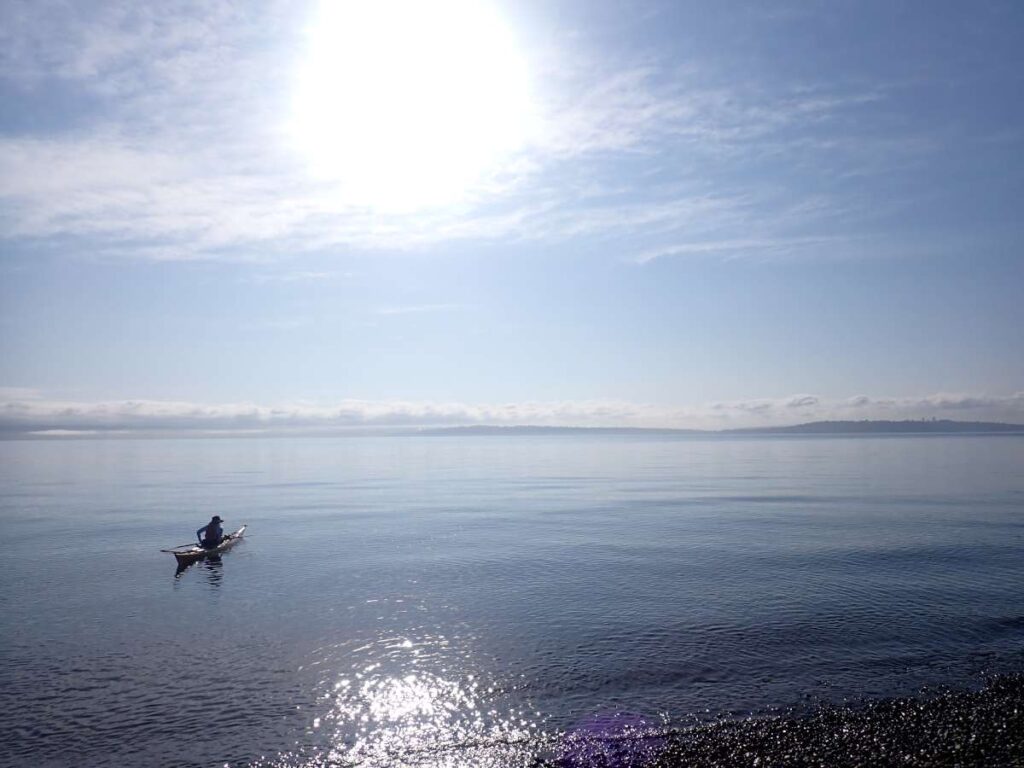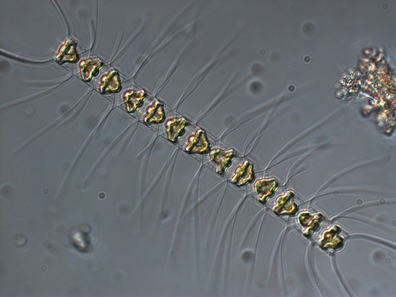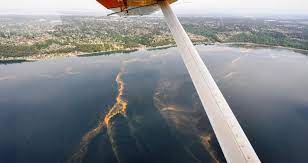The following is a passage from my work in progress, The Kayak Chronicles, about a kayak trip through the Salish Sea during the summer of 2020 -Woody

The ocean is a desert
With its life underground
And a perfect disguise above
A Horse With No Name – America
This lyric has stuck in my head since this first time I heard it on the radio, sometime in the early 1980s. As a kid, riding the school bus along Ocean Road in Narragansett, RI, I’d look out over the expansive Atlantic Ocean, slate gray, ironed flat, with no signs of life anywhere, and I’d think, “The ocean is a desert,” marveling at the wisdom emanating from the classic rock station.
This lyric was stuck in my head again on this morning as we paddled northward toward Bainbridge Island. The seas were absolutely still. Nothing stirred the water’s inky, gray surface. It looked like an oil slick. Scanning the horizon, I couldn’t even spot a gull flittering past. Nothing. Like a desert.
But of course, there was plenty of life, just as there’s plenty of life in the desert. There just weren’t any plants, and in particular, no trees.
Arguably, the most impactful thing I learned studying oceanography for three years was why there aren’t trees growing in the ocean. This might seem like a silly notion, but hear me out. On land we have trees. Lots of them. I recently read that there are roughly three trillion trees on earth, or about 422 trees per person. The land is effectively painted with trees (probably why Bob Ross was so popular). The only place on land that you don’t find trees is the desert, which is why that catchy song lyric rings so true.
But here’s the thing: there are no trees in the desert because there’s no water (or at least, not enough water for trees.) This is not a problem in the ocean, where roughly 98% of the earth’s water can be found. So why aren’t there any trees?
“Trees can’t handle saltwater,” you might say.
That’s not really true. Mangrove trees grow along tropical coastlines around the world, the roots completed submerged in briny warm, saltwater. But mangroves do need something for their roots to grow in. And that’s the problem with the ocean. There’s nothing solid in it.
For us bipedal hominids descended from tree-dwelling primates, the world exists in solid, immutable forms. Mountains don’t move. Canyons don’t move. Valleys don’t move. Your front yard doesn’t move. But if you live in the ocean, everything is moving all the time. In the ocean world, having roots (and branches, for that matter) is a big problem. Waves, currents, eddies and swell are constantly churning the very substance in which you live. Having long, rigid things sticking out you presents risk of damage. This is why the bull kelp that grows throughout Puget Sound is long and rubbery. It can whip around in the current and waves without a problem. Even during the smallest summer swell, an oak tree would get thrashed.
The other way of dealing with life in an ever-moving, liquid world, is to be very small. Like microscopic small. You see, when you’re really small, the force of the water doesn’t hurt you. Why? Because basically you are one with the water. It’s sort of like in the old martial arts film, where the master tells his student to bend with the force. If you try to oppose it, you’ll break, but if you go with it, you’ll be fine. The real plants of the ocean – the phytoplankton – are really, really tiny. Most are so small that, clumped one next to the other, you could fit a hundred of them inside the period at the end of this sentence.

When you’re that small, water behaves completely differently. It’s no longer the splashy stuff we’re used to, but instead it’s like a thick glue and phytoplankton just hang there, stuck in it. This isn’t a buoyancy thing. It’s not like a SCUBA diver floating in the water. These phytoplankton are stuck, as if in molasses or oatmeal. So when the water churns and swirls, they just churn and swirl with it.
As an added benefit, being stuck means the phytoplankton don’t sink as easily, which is important because all of the sunlight they need is at the top of the ocean. Down below it’s too dark for photosynthesis, so the longer they can stay at the surface, the better. Well, in terms of sunlight anyway. Unfortunately, the nutrients (things like nitrate of phosphate that the phytoplankton need to grow) aren’t at the surface where the sunlight is – they’re at the bottom, where’s it’s dark and gloomy. Why? Well, that process of decomposition takes time, and in the ocean, time means sinking. As the microbes do their business of decomposition and excrete those nutrients, they sink. Consequently, most of the food for the phytoplankton is down where it’s dark, and there isn’t enough sunlight to use it. Of course, there are some nutrients at the surface, but not much. The surface water is sort of like a fridge in a frat house: lots of taking and not a lot of resupplying.
When you’re trying to access sparse nutrients, being small is an advantage. In the same way that apartment buildings are way more efficient to live in than big mansion, a small organism is way more efficient at doing the stuff of life than a big organism. You could think of all life as trying to take stuff from the environment, process that stuff and then use it to make more stuff. When you’re tiny, that’s easy. When you’re big, it requires a ton of resources. This is why big animals like bears, elephants and blue whales have to cover huge territories to survive; they’ve got a lot of cells to take care of. But when you and a thousand of your friends could all fit inside this “o,” well, it’s easy to get all the stuff you need.
All of this creates a fundamental conundrum for oceanic photosynthesis – plenty of water, plenty sunlight (at least at certain times of the year) and plenty of nutrients, but rarely are all three found together in the same place. Consequently, vast stretches of the ocean are as barren as deserts, which makes me wonder if Dewey Bunnell, and his comrades from America, had studied some biological oceanography before writing that song.
There are special places around the world where water, sunlight and nutrients all come to together. One is what are called upwelling zones, where deep, nutrient rich water is driven to the surface where there’s sunlight for the phytoplankton to grow. These are found in places like the Horn of Africa, the equatorial Pacific and the the west coasts of North and South America. You also get such an arrangement in estuaries, where shallow water lets sunlight pass to the bottom, a close proximity to land supplies ample nutrients and a tidal exchange mixes the biological soup to keep everything growing. And Puget Sound is one such estuary. Now, Puget Sound is very deep and much of it is too dark for photosynthesis, but our big tidal currents cause plenty of mixing (particularly at places like Admiralty Inlet near Port Townsend) to bring deep, nutrient-rich water to the surface where sunlight provides the energy to make biomass for the entire ecosystem. Too much mixing can cause problems for the phytoplankton, however. They need to stay at the surface long enough to absorb sunlight and nutrients, and if they’re mixed down into the dark water, they won’t have enough time to grow.
In Puget Sound, stratification is the key to high productivity. In order for phytoplankton to bloom, they need some layering, or stratification, of the water column. If you’ve ever been swimming and dove down and felt the water go from comfortably pleasant to shockingly cold, you’ve experienced stratification. Warmer, less dense water is sitting on top colder, denser water. If you were a phytoplankton, it would be hard to sink into that cold water. Instead, you would just sit in the warm, sunny water sucking up the nutrients and reproducing like crazy. As Richard Strickland describes in The Fertile Fjord, Puget Sound is exceptionally productive because of the patchy nature of mixing and stratification. Most of the phytoplankton in Puget Sound grow in a series of intermittent blooms surrounded by areas of low productivity. This patchiness allows for intense growth in one spot, while others areas stay dormant. It’s sort of like a farmer rotating crops and letting some fields lay fallow so as not to deplete nutrients in the soil. Because this process occurs in a fluid world, the growth from one area will mix with other locations, nourishing the food chain throughout the Sound, and providing food for everything from rockfish, to harbor seals to killer whales. None of which you’ll find in a desert, by the way.

If you want to see what this patchiness looks like, check out Eyes Over Puget Sound. EOPS is the work of Dr. Christopher Krembs, who started taking photos of Puget Sound while on short flights between sampling stations around the region. Dr. Krembs realized that by combining his photos with data from ferries, moored instruments and other observations he could document important ecosystem processes throughout Puget Sound. Since 2011, Dr. Krembs has been releasing monthly EOPS reports that cover everything from algal blooms, to wildlife behavior to oil spills. Looking at the photos of swirling Noctiluca blooms, internal waves and turquoise rivulets I’m reminded of just how lucky I am to live in the Puget Sound bioregion, which has been providing sustenance and safe harbor to bipedal hominids for thousands of years.
But I can also see how fragile it is, and how the millions of us who live along its shores are impacting its health. Our developments destroy its wetlands, our highways spread petroleum throughout its coastlines and our cities dump a slew of chemicals into the water. It takes just the right combination of factors to make such a productive and dynamic ecosystem. Can it withstand all the changes modern civilization has brought? I don’t know. Salmon runs have been obliterated. Rockfish have tanked. And in the last decade, we’ve seen massive declines in seabird populations. Maybe we need to start thinking about Puget Sound as a desert, a precarious ecosystem where life is barely holding on. Maybe then we could just leave it alone and let it go back to doing what it’s done since Seattle was buried under 3000 feet of ice.